Vol 4 No. 34 TROPIC LIGHTNING NEWS August 25, 1969
Index
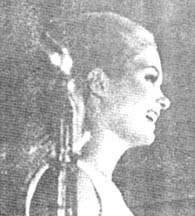 |
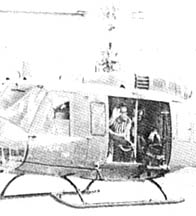 |
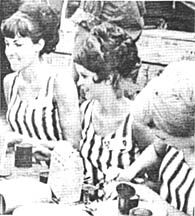 |
Miss
America Wears Combat Boots
By
SP4 John Haydock
CU CHI – There was no Bert
Parks and no fanfare, but there she was, Miss America, landing on the Tropic
Lightning Taro Leaf on 2d Brigade’s Warrior helipad.
Judi Ford, Miss America,
1969, and six members of her “court” were out to spend the day with Tropic
Lightning troops on one leg of their two-week visit to Vietnam.
With her were Miss
Minnesota, Charlotte Sims, Miss New York, Pat Burmeister, Miss Missouri, Kathi
Goff, Miss New Jersey, Linda Wilmer, Miss Arkansas, Helen Gennings, and Miss
Kentucky, Janet Hatfield.
After a short stay at
Waikiki East, the Division swimming pool, the girls headed back to the Warrior
Pad and out to Fire Support Base Pershing, manned by the Fire Brigade’s 2d
Battalion 12th Infantry.
There they were given a
royal choice of 12 different meals – all C-rations.
Next stop for the troupe was
the Tay Ninh Service Club. A more
than capacity crowd of 600 jammed the small auditorium to watch the talented
performances of the seven beauties.
At the 3d Brigade’s Fire
Support Base Jackson, the girls again met with line troops and clicking cameras.
The last landing point before they returned to Cu Chi and bedside visits
at 12th Evacuation Hospital was Fire Support Base Devins, for a short
stay with 2d Brigade soldiers from the 1st Battalion (Mechanized), 5th
Infantry.
A real base camp supper was
provided for the pretty ambassadors by the 25th Supply and
Transportation Battalion. Each girl
was escorted by a GI from her home town, or a town very close to it.
The day in Tropic Lightning
country closed with another show, this time in the hanger of the 125th
Maintenance Battalion.
| Remember how glad you were to get that last letter from home. Think of how interested you are in what’s happening there. Wonder how you would feel if it was your mother or father or wife or sister or brother who was here and you were at home. Have you written home lately? |
Hot LZ
Leads All-day Fight Between 2d Wolfhound, NVA
By PFC
CRAIG SAMPSON
CU CHI – Wolfhound
infantrymen of the 2d Battalion, 27th Infantry, killed 34 North
Vietnamese Army regulars and captured two .30 caliber anti-aircraft machineguns
in day-long fighting 18 miles west of Cu Chi Aug. 12.
The site of action was near
the Tram Canal, known to be a major enemy infiltration route.
Alpha Company troopers first
encountered the estimated 200 enemy as they hit a hot landing zone.
The first of two four-ship lifts received heavy small arms and RPG fire
from nearby hedgerows. Although enemy fire was coming from three directions, the
heaviest volume of fire came from a large hedgerow complex 250 meters to the
Wolfhounds’ front.
INITIAL
ATTEMPTS
to assault the positions were unsuccessful as automatic weapons fire pinned the
American troops to the ground.
Immediately, gunships from
the 116th Assault Helicopter Company spotted the enemy positions and
took them under fire while the infantrymen troops hugged the ground. Under the suppressive fire, they were able to pull back to
protective berms.
The second four-ship lift
set down 200 meters west of the original contact area.
Met with small arms and RPGs as they touched down, the Wolfhounds fought
ferociously to counter the enemy fire and link up with the troops from the first
lift.
Gunships continued to strafe
the hedgerows while ground troops kept pressure on the well dug-in positions.
Enemy anti-aircraft machine guns opened up on the helicopters.
High above, a Centaur gunship spotter located a machinegun position and
marked it with a smoke grenade. A
gunship rocket followed, right on target, eliminating the position.
AFTER
THE GUNSHIPS
had worked over the hedgerows, supporting artillery fire was called in from Fire
Support Bases Jackson and Hampton and the combined U.S.-ARVN compound at the
Sugar Mill. The enemy resistance
weakened but still the NVA held tight to their positions.
 “It’s hard to see how
they could take so much,” said Private First Class Charles Wellman of
Argillite, Ky.
“It’s hard to see how
they could take so much,” said Private First Class Charles Wellman of
Argillite, Ky.
To reinforce Alpha company
and secure the left flank, Delta Company of the 2/27th Wolfhounds was
inserted 200 meters to the rear. Their
nine-ship lift also drew small arms and RPG fire at touch-down.
Responding rapidly with
automatic weapons fire, they were successful in stilling the enemy fire and made
their way up to Alpha Company’s forward positions.
From there they applied heavy fire upon the fortified bunkers in the
hedgerows.
AIR
STRIKES WERE called
in on the entrenched positions to relieve pressure from the ground troops so
resupply ships could come in.
For support on the extreme
right flank, the third platoon of Bravo Company was brought in by eagle flight.
“We lit out in the open
and the NVA started firing at us, so we (Continued on Back Page)
THE BATTLE IS
OVER.
But its effects are evident on the face of 2d Battalion, 27th
Infantry Wolfhound grenadier Private First Class John Fahey of New York City.
Fahey was taking a breather after a day-long Wolfhound-NVA battle near
Fire Support Base Jackson. (PHOTO
BY PFC PHIL JACKSON)
Page 2 TROPIC LIGHTNING NEWS August 25, 1969
 Peskier than a Speeding Bullet
Peskier than a Speeding Bullet
Mosquitoes:
A Dangerous Foe
About the only sound worse
than a mosquito buzzing around your ear is of a bullet whizzing past, and with
the bullet you at least know it’s not coming back to bother you any more.
The mosquito is more
persistent. You may have noticed.
THOSE OBNOXIOUS insects that
so enjoy bothering humans are more than just pests, though. They’re dangerous.
Vietnam is full of
mosquitoes (most of which probably seem to be in your bunker or hootch), and
many of those mosquitoes are malaria carriers.
There are two types of
malaria: falciparum, which can keep
you sick with chills, fever, sweating and headaches for as long as two years,
and vivax, which can keep you dead.
There are two ways of
keeping clear of both kinds, avoiding mosquito bites in the first place, and
taking anti-malaria pills.
MOSQUITOES
SHOW
sense enough to avoid the heat of the day in Vietnam, coming out at dusk and
retiring at dawn. So once it starts
getting dark, you’re well-advised to roll down your sleeves and smear insect
repellent all over exposed parts of your body as well as over clothing that is
stretched over the shoulders, ankles and buttocks.
If possible, you should use
a net over your sleeping area, too.
Despite the most extensive
precautions and most thorough anti-mosquito search and destroy missions,
however, a few bites are unavoidable.
That’s why we take the
pills.
THE
BIG FAT orange
pill, taken once a week, makes up for the gaps in the coverage affording by the
little white pill, which is taken once a day.
Since nobody is likely to
stand on your chest and force your jaws open so he can shove the pills down your
throat, it’s a good idea to get in the habit of taking them.
You should also take enough
pills home with you on your DEROS so that you have a eight weeks’ supply of
orange pills and enough white ones for 30 days.
This is to prevent any malaria germs from causing trouble after you leave
Vietnam.
Dahlinger
Becomes Judge
By SP4
GARY D. SCIORTINO
CU CHI — Major Richard K.
Dahlinger of Burlingame, Calif., the 25th Infantry Division’s Deputy Staff
Judge Advocate, was sworn in here recently as the first military judge in the
division.
He became a judge in
accordance with new provisions of the Uniform Code of Military Justice (UCMJ)
which went into effect August 1. The
changes in the UCMJ were brought about by the Military Justice Act of 1968.
DAHLINGER
CAN NOW
be detailed to preside over special courts-martial when requested to do so by
the convening authority.
Previously, under the UCMJ,
a military judge was assigned only to a general courts-martial, the
highest-level trial court in the military. Now, however a military judge may be
assigned to special courts-martial (intermediate trial court) as well. General
courts-martial usually hear cases involving felony-type and serious military
offenses, special courts-martial usually try misdemeanor cases and minor
military offenses.
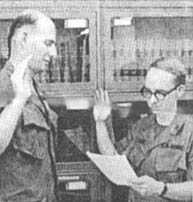 The sentencing power of the
special courts-martial is limited to imposing up to six months confinement at
hard labor, partial forfeitures of pay and reduction to the lowest grade for
enlisted men. In addition, under
the new Military Justice Act, a special courts-martial can be empowered to
sentence an accused person to a bad conduct discharge.
The sentencing power of the
special courts-martial is limited to imposing up to six months confinement at
hard labor, partial forfeitures of pay and reduction to the lowest grade for
enlisted men. In addition, under
the new Military Justice Act, a special courts-martial can be empowered to
sentence an accused person to a bad conduct discharge.
“THE
NEW LAW,”
stated Major Dahlinger,” permits a qualified military lawyer to decide
complicated legal issues, thus leaving court members to decide only the guilt or
innocence of the defendant based on the facts presented to the court and
determine an appropriate sentence. This
frees the president of a special courts-martial, who has traditionally been an
officer without legal training, from having to decide the answers to legal
questions.”
HERE IS THE
JUDGE
- Major Richard K. Dahlinger (right) 25th Infantry Division Deputy Staff Judge
Advocate, becomes the division s first military judge as he is sworn in by Major
Dennis R. Hunt, a Deportment of the Army Judiciary officer.
Decorated
| DISTINGUISHED FLYING CROSS | |
| W01 Robert D. Staggs, Co B, 25th Avn Bn | |
BRONZE STAR FOR HEROISM |
|
| CPT
Paul M. Dixon, Co C, 4th Bn, 23d Inf CPT H.D. Neal, A Btry, 7th Bn, 11th Arty CPT Arthur I. Johnson, HHS Btry, 7th Bn, 11th Arty CPT Charles E. Campbell, HHC, 2d Bn, 12th Inf 1LT Don L. Smith, A Btry, 7th Bn, 11th Arty 1LT Donald W. Miller, Co B, 2d Bn, 27th Inf 2LT Robert J. Simpson, Co C, 2d Bn, 12th Inf 2LT Danny E. Mull, Co C, 2d Bn, 12th Inf 1SGT James E. Wirt, A Btry, 7th Bn, 11th Arty SFC Gonzoles A. Marquez, Co C, 2d Bn, 27th Inf SFC Marvin P. Rothrock, A Btry, 7th Bn, 11th Arty SFC Gregorio Mirelies, A Btry, 7th Bn, 11th Arty SSG David P. Hutto, HHC, 1st Bn, 5th Inf SGT William V. Kane, Co D, 1st Bn, 27th Inf SGT Roger E. Edmond, A Btry, 7th Bn, 11th Arty SGT Conrad Garcia Jr., Co C, 2d Bn, 27th Inf SGT Ronald P. Duran, A Btry, 7th Bn, 11th Arty SGT Ralph E. Roberts, Co C, 2d Bn, 12th Inf |
SGT
John L. Clark, A Btry, 7th Bn, 11th Arty SP5 James A. Dale, HHC, 2d Bn, 12th Inf CPL Michael S. Cziska, A Btry, 7th Bn, 11th Arty SP4 Terry O. Riddell, A Btry, 7th Bn, 11th Arty SP4 Arrie Eliff, A Btry, 7th Bn, 11th Arty SP4 Glen F. Moorman, A Btry, 7th Bn, 11th Arty SP4 Michael D. Derosier, A Btry, 7th Bn, 11th Arty SP4 John E. Mohlar, Co C, 4th Bn, 23d Inf SP4 Thomas C. Barker, Co C, 2d Bn, 27th Inf SP4 Albert F. Lewis, A Btry, 7th Bn, 11th Arty SP4 Larry D. Mette, A Btry., 7th Bn, 11th Arty SP4 Tommie J. Dyer, Co D, 1st Bn, 27th Inf SP4 William J. Hurley Jr., Co C, 2d Bn, 27th Inf SP4 Richard Burhans, Co A, 65th Engr Bn SP4 Bruce J. Ianello, A Btry, 7th Bn, 11th Arty SP4 England L. Rogers, Co E, 1st Bn, 27th Inf SP4 Robert J. Unser, Co E, 1st Bn, 27th Inf SP4 Joseph P. Haley, HHC, 1st Bn, 27th Inf |
Tropic Lightning Tots
The Commanding General Welcomes
The Following Tropic Lightning Tots
To The 25th Infantry Division – As
Reported By The American Red Cross.
Born To:
| August
2nd SP4 Larry E. Talbert, 1st Bn. 8th Arty, a boy, Aug. 2 August 3rd PFC Chamberlain Ferry, 2d Bn, 27th Inf, a girl, Aug. 3 August 4th SP4 William M. Hukowicz, 65th Engr Bn, a girl, Aug. 4 August 5th SSG Joseph Miracle, 2d Bn, 77th Arty, a boy, Aug. 5 SP4 Patrick R. O’Conner, 3d Bn, 13th Arty, a boy, Aug. 5 PVT Billy Colburn, 3d Sqdn, 4th Cav, a girl, Aug. 5 |
August
6th CPT Joseph Prince, 25th Avn Bn, a boy, Aug 6 lLT Timothy Talbot, HHB DIVARTY, a girl, Aug. 6 SP4 Kenneth Dockery, 1st Bn, 27th Inf, a boy, Aug. 6 SP4 David Arias, 2d Bn, 12th Inf, a boy, Aug. 6 PFC James L. Kent, 3d Sqdn, 4th Cav, a girl, Aug. 6 August 7th SP4 John Hayes, 1st Bn, 8th Arty, a girl, Aug. 7 August MAJ Charles M. Borne, HHC, 25th Inf Div, a girl, Aug. |
The TROPIC LIGHTNING NEWS is an authorized publication of the 25th Infantry Division. It is published weekly for all division units in the Republic of Vietnam by the Information Office, 25th Infantry Division, APO San Francisco 96225. Army News Features, Army Photo Features, Armed Forces Press Service and Armed Forces News Bureau material are used. Views and opinions expressed are not necessarily those of the Department of the Army. Printed in Tokyo, Japan, by Pacific Stars and Stripes.
MG Ellis W. Williamson . . . . Commanding General
MAJ John C. Fairbank . . . . . Information Officer
1LT John C. Burns . . . . . . . . Officer-in-Charge
SP5 Charles Witrow. . . . . . . Editor
SP5 Ralph Novak . . . . . . . . . Assistant Editor
SP4 David DeMauro. . . . . . . Production Supervisor
BATTALION CORRESPONDENTS
| SGT Jon Anderson SP4 Dennis Dibb PFC John Frame PFC Sam Dixon SP4 K.C. Culen SP4 Arthur Brown PFC Larry Goodson SP4 Pete Freeman |
1/5 1/5 4/23 4/23 3/22 2/12 2/12 7/11 |
PFC Richard Sears SP4 Carl Detrick PFC Frankie Ditto PFC Victor Allison PFC Phil Jackson PFC Craig Sampson SP4 Pat Morrison |
4/9 2/34 2/14 3/4 2/27 2/27 3/13 |
Tropic
Lightning
Combat Honor Roll
Private First Class Thomas
J. Fields of the 1st Battalion (Mechanized), 5th Infantry Bobcats, is the latest
addition to the 25th Infantry Division Combat Honor Roll.
Fields distinguished himself
July 10 while serving as a member of the Bobcats’ Reconnaissance Platoon.
The
platoon encountered a squad-size enemy force and opened fire.
When the communist force returned fire, Field stood up in the midst of
the battle to pour suppressive M-60 machinegun fire on the aggressors.
Although he was exposed to the devastating hail of hostile fire, Fields
moved to a more advantageous position to continue his relentless fire on the
insurgents.
His valorous actions were
instrumental in thwarting the enemy force.
Fields was awarded a Bronze
Star for Heroism by Division Commander Major General Ellis W. Williamson in
ceremonies Aug. 15.
In the same ceremony, Major
Sanh, District Chief of Cu Chi Sub-sector, received a Bronze Star for heroism
for gallantry in a combined action.
You
Can Write Letter, Win $1000
You still have a chance to
win a $1000 Prize for a 500-word letter on My Hopes for America’s Future”.
Letters, with a 500-word
maximum, must be submitted by November 1 to Freedoms Foundation, Valley Forge,
Pa. 19481. The only restriction on
content is that letters must follow the contest theme.
Writers should include their
name, rank, service number, social security number, full military address, unit
and full home address.
Notification of winners will
be made in February 1970.
Page 3 TROPIC LIGHTNING NEWS August 25, 1969
NVA
Medic Rallies, Helps Wolfhounds
By SP5 JACK ANDERSON
CU CHI – Le Van Toan made
a lot of people happy when he rallied to the Government of Vietnam.
Le, a former North
Vietnamese Army Medic, took full advantage of the government’s Chieu Hoi
program and was indeed received with open arms by many thankful people in Hau
Nghia Province.
Now, Le is putting his
medical knowledge to use, this time to help the people of the South rather than
give aid and comfort to their enemies.
“LE HAS BEEN HIGHLY
trained in medicine by Hanoi and he is extremely efficient in the use of
medicines we have on hand,” said Captain Alfred S. Bradford of Appleton, Wis.,
who has accompanied Le on many Medical Civic Action Projects sponsored by the 1st
Battalion, 27th Infantry Wolfhounds.
Le’s learned beside manner
was demonstrated recently on a MEDCAP in Xom Giong Dau, about eight miles south
of Cu Chi.
“Many of the villagers
went directly to Le instead of an American medic,” said Bradford. “That’s rather out of the ordinary because most of the
people usually feel an American medic knows more about treating them than a
Vietnamese. It’s just more proof
that the people respect this man’s ability as a medic and respect him for
coming over to the Vietnamese government.”
BUT LE DOES MORE than just
prescribe pills and bandage bumps and bruises.
He’s a valuable tool in telling the benefits of the Chieu Hoi program.
“He’s always explaining
the program to villagers – telling them of what they, or people they know, can
expect from the Government of Vietnam,” said Bradford, the Wolfhounds’ Civil
Affairs Officer. “What better
example can these people have than Le? He’s
living proof of the future that awaits ralliers.”
THE WOLFHOUNDS ALSO have two
Kit Carson Scouts who help them with MEDCAPs.
Vo Thanh Tung, a former Viet Cong, acts as an interpreter and helps clean
and bandage wounds.
Nguyen Van Mai, the other
scout, received on-the-job training for his position on the MEDCAP team while
still in the employ of the Viet Cong.
“Nguyen was a member of an
armed propaganda team. Now instead
of reciting the virtures of the communist way, he explains the benefits of
rallying to the government of the South,” Bradford said.
Center
Trains Hoi Chanhs
By PFC ROBERT STEPHENS
BAO TRAI – Troopers from
the 3d Brigade are getting a helping hand these days from the Chieu Hoi Center
at Bao Trai, six miles southwest of Cu Chi base camp.
Thanks to the center’s
efforts, 162 enemy soldiers recently became ralliers to the Republic of Vietnam
in less than a 20-day period. One
hundred sixteen of these were actual combatants, 24 were laborers, and 22 were
political propagandists.
THE CHIEU HOI program
consists of a Viet Cong or NVA soldier rallying to the RVN government.
The first step after rallying is 45 to 60 days of debriefing and
vocational training at the center in Bao Trai.
Since most of the hoi chanhs
(ralliers) are tired, hungry and without proper clothing, the first days are
spent satisfying these basic needs. They
are paid a basic ration for clothes and food.
There is a cafeteria inside the center where meals are prepared.
During the first few days of
debriefing, ralliers are given a chance to volunteer any tactical information
they might have. This is where the
center really helps the soldier in the field.
Cash bonuses are given for leads and Hoi Chanhs supply valuable data on
the location of booby traps, bunker complexes, and enemy elements.
A POLITICAL orientation with
an explanation of the Saigon government and its goals follows the preliminary
debriefing.
For the remainder of their
stay at the Bao Trai center the Hoi Chanhs learn a new vocation.
Such subjects as farming, carpentry, barbering and tailoring are taught
in classes held daily at the center’s compound.
Thus, the rallier will be sure of employment when he completes the
center’s course.
The Chieu Hoi program is
concluded with a graduation ceremony at the Hau Nghia Province capital building
in Bao Trai. At this time the Hoi
Chanh is given a sum of money and has the choice of either entering some phase
of the military or returning home as a free civilian.
 |
| FILE FROM THE RIGHT – With notebooks in hand, hoi chanhs at the Bao Trai Center file into one of their classes. (PHOTO BY PFC ROBERT STEPHENS) |
1st,
2d ‘Hounds United; Wolf Pack Prowls Again
CU CHI - The 1st and 2d
Battalions, 27th Infantry Wolfhounds, have united forces again under
the 3d Brigade. The highly
decorated battalions were separated in late 1968.
The battalions were reunited
when the 3d Brigade moved from its base camp at Dau Tieng to a new area of
operations at Cu Chi.
THE TWO UNITS came to
Vietnam as part of the Division’s 2d Brigade from their headquarters at
Schofield Barracks, Hawaii.
They landed at Vung Tau in
January, 1966, immediately starting a push northwest of Saigon into Hau Nghia
province. In this area, the two
‘Hound battalions were to help establish Division headquarters at Cu Chi.
Operation Wahiawa, from
16-27 May 1966, cooled a few Viet Cong heels.
The Wolfhounds killed 157 enemy and captured 885 tons of rice, along with
large amounts of field equipment.
AFTER CLEARING most of the
Viet Cong from their immediate area, the Wolfhounds worked in defense of Saigon.
They harassed staging areas and blocked enemy infiltration routes from
Cambodia.
 Operations Kole Kole and
Atlanta in 1967 took a heavy toll of enemy forces, ending a 10-year Viet Cong
reign in Hau Nghia province. An
estimated 2,264 enemy died in the action.
Operations Kole Kole and
Atlanta in 1967 took a heavy toll of enemy forces, ending a 10-year Viet Cong
reign in Hau Nghia province. An
estimated 2,264 enemy died in the action.
From December 1967 to May
1968, the Lightning forces embarked on Operations Saratoga and Toan Thang.
The mission was to engage the enemy and destroy his rocket-launching
capabilities.
DURING THE TET offensive of
early 1968, the Wolfhounds worked in defense of Saigon. The 1st and 2d Battalions pushed the 222d Viet Cong Regiment
out of the Tan Phu - Trung Ap Cho areas in February 1968, leaving 219 enemy
dead.
WOLFHOUND INFANTRYMEN from the 2d Battalion, 27th Infantry pour out the firepower during a battle near Cu Chi in the early days of the Tropic Lightning’s participation in the Vietnam war. It’s just like old times for the two Wolfhound battalions, which are operating together again under the 3d Brigade.
Enemy
CO Surrenders
By 1LT J. T. RICHARDS
CU CHI - A battalion
commander of the combined Viet Cong-NVA Quyet Thang regiment gave himself up to
local Vietnamese forces within the 2d Brigade operations area recently.
Ha Van Hot rallied to the
side of the government of the Republic of Vietnam in the Phu Hoa district.
He was taken temporarily to Paris Tan Quy and from there to province
headquarters at Binh Duong. There
it was confirmed that he was commander of the 1st Battalion of the Quyet Thang
regiment.
CAPTAIN PAUL D. Dexter of
Worcester, Mass. 2d Brigade assistant S-2 said Ha held the rank of either a
senior captain or major. Dexter
said the former enemy commander had decided to Chieu Hoi for a number of
reasons:
Food had become scarce. The
situation was “hopeless.” It
was impossible to control his men.
Later Ha told first
Lieutenant Henry G. Schwan of Cincinnati, Ohio, 2d Brigade assistant S-5, he
surrendered because he “wished to avoid a miserable life and a senseless
death.” The new hoi chanh added
that he knew that the Viet Cong could not win the war.
He knew about the Chieu Hoi program from leaflets and broadcasts in his
area.
IT WAS ALSO discovered that
Ha had an even simpler and more down to earth reason for rallying.
“I believed that I would
be well treated,” he told the 2d Brigade’s interpreter, Ly Viet Hoang.
“I have never had the good fortune of sleeping on a bed with sheets.
Now this will be the first time in my life and my wife’s that we will
have beds with sheets.”
The 1st Battalion of the
Quyet Thang regiment was made up of three companies of 117 men each.
Its mission was to act as a security force for the 268th and
101st Regiments, which are scattered throughout the area.
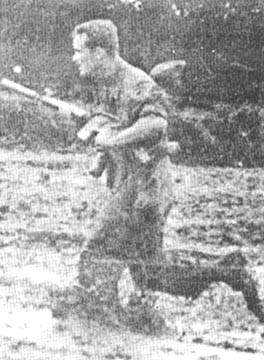 |
IN
HOT PURSUIT - Specialist 4 Harold D. Ruff of Tower Hill, Ill. Loses his hat
while charging a suspected enemy position during a 2d Battalion, 14th Infantry
Golden Dragon operation. The
soldiers detained a Viet Cong suspect who gave valuable information about enemy
activity. (PHOTO BY PFC FRANK DITTO) |
Page 4-5 TROPIC LIGHTNING NEWS August 25, 1969
This issue's two-page photo spread is not included to conserve space.
Page 6 TROPIC LIGHTNING NEWS August 25, 1969
‘To
See a Child Live, Smile
By SP4 K. C. CULLEN
TAY NINH - A doctor is a
rare person in the cities and villages of Tay Ninh Province, and when the doctor
is a children’s specialist he become rarer than snow on Nui Ba Den.
Captain Robert B. Rhoades of
Gainsville, Fla., battalion of the 3d Battalion, 22d Infantry Regulars, has
found a challenge in treating children in the pediatric ward of the Provincial
Hospital in Tay Ninh City.
RHOADES BEGAN WORKING at the
hospital about four months ago. Various
fevers, malaria, worms, anemia and an assortment of tumorous disorders confront
the busy doctor every day.
“The range of different
cases within the field of pediatrics is giving me a background I would never be
able ot achieve in the United States. I
am becoming a specialist within a specialty field,” explained Rhoades.
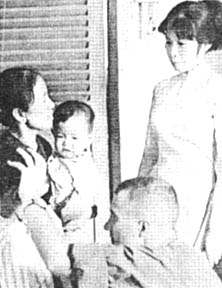 In diagnosing and
prescribing treatment, communications problems arise.
Interpreters have only a passing knowledge of modern medicine.
And even when the best treatment is recommended and understood, Rhoades
has to compete against age-old Chinese folk medicine.
In diagnosing and
prescribing treatment, communications problems arise.
Interpreters have only a passing knowledge of modern medicine.
And even when the best treatment is recommended and understood, Rhoades
has to compete against age-old Chinese folk medicine.
TRAINED NURSES administer
medicine and injections, but everyday cleansing and care of the patients is
performed by relatives of the children. Mothers,
fathers and sometimes entire families live in the ward, sleeping on the floor
and benches.
At times the Vietnamese tend
to disregard the doctor and revert to treatments their ancestors used for
centuries.
Even with all the stumbling
blocks, however, the ward and the treatment do improve.
“THEY WERE CENTURIES
behind modern medicine just a few years ago and although they are still behind,
they are steadily closing the gap. The
real battle is in overcoming the superstition and folk medicine, which was all
they had before,” commented Rhoades.
Is it worth the frustration
and problems? Rhoades says, “To
see a child live and smile when he was a shadow near death only a week before
makes it all worthwhile.”
TO
HELP A CHILD - Captain Robert Rhoades of Gainesville, Fla., battalion surgeon of
the 3d Battalion, 22d Infantry examines a child’s eye during an open clinic of
the Provincial Hospital in Tay Ninh City. The
concerned mother of the child tells his problems to an interpreter.
Bravo
Manchus Open Travel Lodge East’
By PFC RICHARD W. SEARS
TAY NINH - New York has its Waldorf-Astoria, Chicago its Hilton and Miami its
Fontainebleau. Now Bravo
Company’s area in the 4th Battalion, 9th Infantry Manchus’ section of Tay
Ninh base camp has its Travel Lodge East.
The lodge was recently
opened as a base camp rest and relaxation area by the men of Bravo Company.
It sports a regulation-sized pool table, a television set and four
sleeping rooms featuring beds with clean white sheets and overhead fans.
 Bravo men in from the field
for appointments, one-day stand-downs or to go on leave or R&R stay in the
Travel Lodge East.
Bravo men in from the field
for appointments, one-day stand-downs or to go on leave or R&R stay in the
Travel Lodge East.
The lodge was dedicated by
Bravo Company’s commanding officer, Captain Ronald J. Cabral of Fall River,
Mass.
“This building will have a
plaque with the names of those men who have died in action with the Bravo
Company Manchus,” said Cabral. “That’s
one way to show our appreciation for what they have given in many instances to
save men who will stay here.”
Cabral initiated action that
brought Bravo’s Travel Lodge East into existence.
BUILDING
INSPECTOR - Designer and builder of the 4th Battalion, 9th Infantry
Manchus’ Bravo Company Travel Lodge East, Specialist 4 Dave Boatwright of
Lexington, Okla., looks over his work. (PHOTO
BY PFC RICHARD W. SEARS)
Radar,
Arty Control Night
CU CHI - The 2d Battalion, 12th Infantry Warriors and 1st Battalion, 8th
Artillery, are combining radar and 105mm howitzers to prevent the enemy from
making an ally of the night. In a
recent night action, the Warriors’ radar picked up eight to ten people moving
about a mile from Fire Support Base Pershing, where the 1/8’s Bravo Battery is
located.
The battery’s Fire
Direction Center obtained a quick clearance and six 105s began pounding away at
the target provided by the radar.
A UH-1 “nighthawk”
helicopter equipped with a starlight scope and a spotlight was called in to
search the area, and it confirmed a body count of ten NVA soldiers.
Combined
Sweeps Give RFs, PFs Active Role
By PFC ROBERT STEPHENS
BAO TRAI - A series of
combined sweeps involving U.S. and South Vietnamese elements is now underway in
the 3d Brigade area.
It’s all part of a new
program allowing the local Popular and Regional Force units to take a more
active role in the allied war effort. As
Captain Richard Kiernan of Long Island, N.Y., U.S. operations officer for the
Bao Trai area explains, “Our
basic aims are to have the RVNs replacing the U.S. troopers, Regional and
Popular Forces taking over ARVN operations and the CIDG (Civilian Irregular
Defense Group) guarding the hamlets.”
In order for the mission to
be carried out smoothly, coordination of all activities is necessary.
The Regional Forces and their American advisers both have their Tactical
Operations Centers (TOCs) in the same building with an interpreter on hand to
relay information. With each TOC
knowing what the other is doing, wasteful overlapping is eliminated.
The entire system is
designed to operate with a minimum of complexity. Regional Forces in Bao Trai
make the decision to sweep a certain area prior to contacting Kiernan for U.S.
aid. Kiernan then makes
arrangements for transportation, artillery support and blocking forces.
Throughout the entire
operation, the Regional Force commander and Kiernan stay together, each one
informing the other on what his units are doing.
“It’s their show,”
Kiernan says. “I’m just here to
advise and provide U.S. assistance.”
An American advisor
accompanies each RF company to the field to call in gunships or artillery as the
need arises. So
far the project has met with much success. Regional Force units are quickly
molding themselves into disciplined, hard-fighting outfits and their familiarity
with the surrounding countryside makes them more adept at outmaneuvering the
enemy on his own grounds.
Page 7 TROPIC LIGHTNING NEWS August 25, 1969
 |
| DELICATE JOB - Keeping the side of his Cayuse chopper facing toward the bunker line, Warrant Officer Jack Cosby of Huntsville Ala. moves away from the perimeter of Cu Chi base comp. Commo wire connecting Cu Chi with the Vinh Cu ARVN compound was laid over barbed wire and mine fields as it unreeled from a coil inside the helicopter. |
It Beats Walking in Mine Fields
2d Brigade Cayuse Lays Phone Line
By SP4 JOHN HAYDOCK
CU CHI—How do you string
telephone line across five strands of protective wire, around trees, over
Claymore mines and in between hundreds of engineer stakes?
The problem arose recently
for the 2d Brigade, which is in charge of Cu Chi base camp defense.
A line of communication had to be laid between a small ARVN outpost in
the near-by village of Vinh Cu and the defensive bunker line around Cu Chi.
But separating the two
locations were all the obstacles that had been set out to prevent anyone,
friendly or not, from getting through the area.
The line could not be laid by land.
The problem intrigued 2d
Brigade aviation officer Captain Edward W. Cavanaugh and communications officer
Major Frank A. Fiore. Although they
never heard of the job being done that way before, they thought wire could be
laid out from one of the Cayuses, the brigade’s light observation helicopters
used for tactical missions.
Cavanaugh thought the
aircraft could be flown side-ways at a low level while wire from the standard
“donut rolls” was unwound out the door of the LOH.
Warrant Officer Jack Cosby
piloted the Cayuse LOH while Fiore stayed inside paying out the wire.
Meanwhile First Lieutenant Richard Horton of Kingstree, S.C., Master
Sergeant William T. Cook Jr. of Colorado Springs, Colo., Sergeant Gary A. Love
of Oxford, Ohio, and Specialist 4 Harvey Lawson of Terre Haute, Ind., among
others, were on the ground coordinating activities from Cu Chi and Vinh Cu.
|
|
|
|
Photos
by |
Page 8 TROPIC LIGHTNING NEWS August 25, 1969
‘Hounds
Hit Hot EZ, Battle NVA Regulars
(Continued From Page 1) ran for the nearest cover and started firing back,”
said Specialist 4 Kenneth Montgomery of Morgan City, La., in describing the hot
LZ.
AFTER RESUPPLY was
accomplished, air strikes, gunships and artillery fire were lifted. The ground troops began an assault on the enemy positions.
Advancing under smoke screen three times, the Wolfhound force routed out
the enemy, forcing him to retreat some 80 meters to another bunker complex.
Specialist 4 John Fahey of
Queens, N.Y., explained, “We were held up for about a half hour by RPG and AK
fire coming from two bunkers in front of us.
But with the smoke screen we managed to get close enough to throw
grenades in.”
The frontal assault left
many NVA soldiers in confusion. The
remaining enemy soldiers had fallen back to secondary positions.
Air strikes were again called in. As
the heavy ordnance fell enemy soldiers scurried from their bunkers and moved
helter-skelter only to face the accurate fire of gunships as they ran out into
the open.
ARTILLERY, GUNSHIPS and air
strikes continued intermittently to saturate the area, knocking out the
secondary positions. When they were
lifted, Smokey ships flew through, leaving another smoke screen.
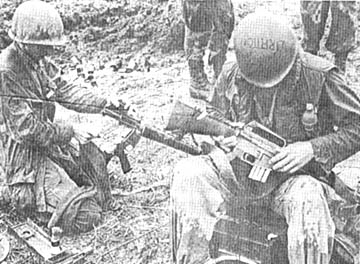 Again the Wolfhounds came on
line for a frontal assault. Still
receiving sniper fire, they overran the fortified bunkers and took up defensive
positions.
Again the Wolfhounds came on
line for a frontal assault. Still
receiving sniper fire, they overran the fortified bunkers and took up defensive
positions.
“There wasn’t much to
take over,” said Private First Class Paul Wedlock of Scranton, Penn.
“The whole area was all bombed-out, blown apart or otherwise turned
upside down.”
To prevent any infiltration
to the west, Delta Company of the 1st Battalion, 27th
Infantry Wolfhounds moved in to set up a blocking force along the west bank of
the Oriental river.
ALTHOUGH SNIPER fire
continued throughout the night, heavy contact was broken by 2000 hours.
After nearly 13 hours of fighting, the three Wolfhound companies occupied
the positions vacated by the NVA.
NEVER
TOO CLEAN - These 2d Battalion, 27th Infantry soldiers fresh from a battle in
which 34 North Vietnamese Army soldiers died waste no time in making sure their
weapons will be ready if they’re needed again.
The 3d Brigade troops were securing an area near Fire Support Base
Jackson. (PHOTO BY PFC PHIL
JACKSON)
Dragon
Recon Unit Hits Like Lightning
By PFC FRANK DITTO
CU CHI - Three UH-1 “Huey” helicopters circle above a small hamlet in Goi
Noi I district, near Trung Lap in the 2d Brigade area of operations.
Suddenly the
command-and-control ship swoops down, sending a marking round to a location near
the hamlet. Before the smoke clears
the three slicks swoop down with precision and timing to drop off a team of men
at the landing zone.
Recently obtained
information has indicated that a Viet Cong tax collector is at work in the
hamlet. The men, sent to check the
information, belong to the reconnaissance platoon of Tropic Lightning’s 2d
Battalion, 14th Infantry Golden Dragons.
FIVE MINUTES FROM the time
the three helicopters touched down outside the hamlet, the small, well-organized
team had moved through the hamlet, checking every bunker and potential hiding
place for Viet Cong and their supplies.
An enemy suspect - perhaps
the tax collector - is detained. The
“Hueys” drop down to pick up the platoon and the suspect.
PLATOON LEADER First
Lieutenant David Stone of Dayton, Ohio, testifies to the high caliber of
performance of his men.
“This is the finest
platoon of men that I have ever worked with,” he says.
“They are a proud, aggressive unit, who really work well together and
will always give 100 percent effort in fighting the enemy.”
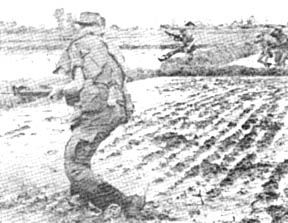 |
SPLASHING THROUGH monsoon mud, men of the reconnaissance platoon of the 2d Battalion, 14th Infantry Golden Dragons move out on an operation near Trung Lap. (PHOTOS BY PFC FRANK DITTO) |
| ONE SQUAD PROVIDES security as the rest of the Golden Dragons’ reconnaissance platoon searches for Viet Cong suspects. |  |
Movies
Have War Role, Too
By SP4 LARRY GOODSON
CU CHI—The fighting men of
the 2nd Brigade have access to yet another means of communication with friendly
as well as enemy forces.
Staff Sergeant Bennie R.
Wells of Mid-West City, Okla., and Staff Sergeant Nguyen Duc Thran of Saigon are
movie projectionists who make up an audiovisual team from the 6th
PSYOP (Psychological Operations) battalion at Bien Hoa. They are presently assigned to the 25th Infantry
Division at Cu Chi.
The team has most recently
been operating in conjunction with the 2d Brigade’s 2d Battalion, 12th
Infantry at Fire Support Base Pershing. This
was an area where a PSYOP activity of this nature had never been carried out.
THE PRIMARY MISSION of the
team is to communicate information to the Vietnamese through the use of motion
pictures. The two men travel
together with their special equipment in a half-ton vehicle.
The team shows the films at
a number of locations that are convenient gathering places for people living in
that vicinity.
There is also a loud speaker
system mounted on the vehicle. Nguyen
uses the system to broadcast news reports and other important information to the
local Vietnamese citizenry. Information
about MEDCAPs, rewards offered for knowledge of enemy activity, and the Chieu
Hoi program make up only a part of the messages conveyed to the public.
THE TEAM ALSO distributes
health kits and school supplies as well as providing family entertainment in the
form of movies of Vietnamese operas and American films.
Wells, commenting on the
operation, said, “The cowboys won the west and now it appears that the West is
winning the East. Most of the
people would rather watch a wild west movie than a Vietnamese opera.”
Nguyen agreed with his
partner. “I’m no exception,”
he said. “The western is also my
favorite too.”
 |
| GIANT B-52 BOMBERS shake up Nui Ba Den with a strike near Dau Tieng. The gunship from the 116th Assault Helicopter Company (left) was in Nui Ba Den territory to refuel before continuing a mission in support of 2d Brigade troops. (PHOTO BY SP4 KARL KARLGAARD) |
Thanks to
Ron Leonard, 25th Aviation Bn., for locating and mailing this issue,
Kirk Ramsey, 2nd Bn., 14th Inf. for creating this page.
This page last modified 8-12-2004
©2004 25th Infantry Division Association. All rights reserved.